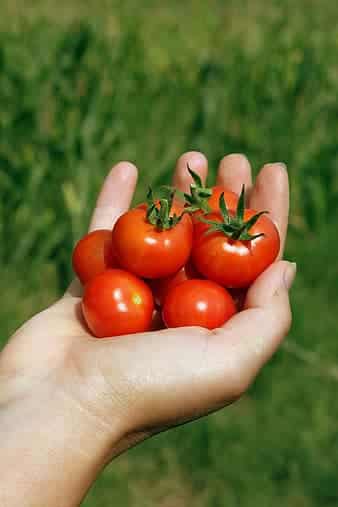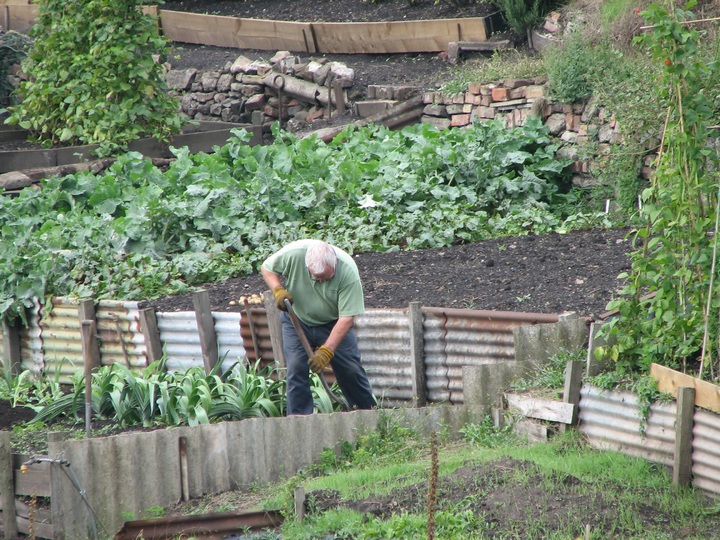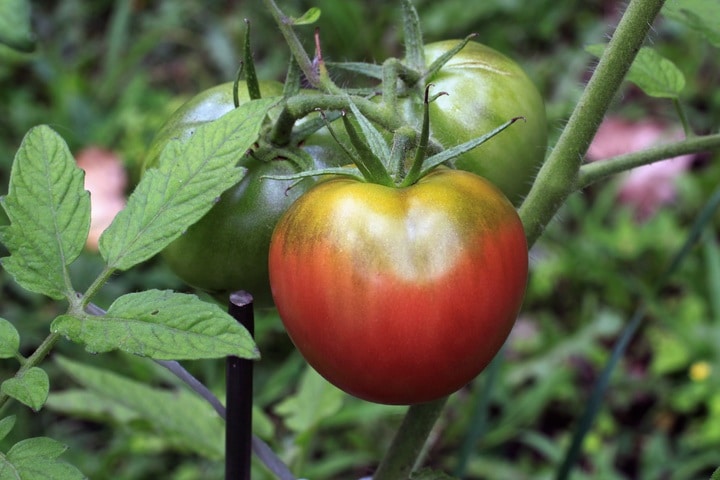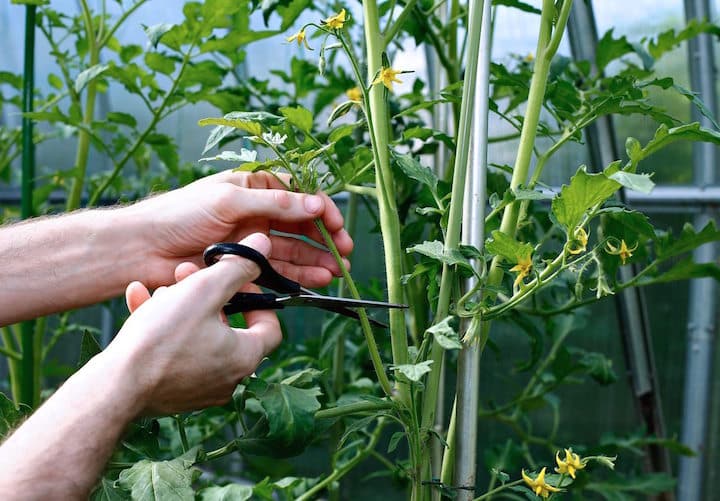For a great tomato with rich tastes, heirloom tomatoes are hard to beat. They offer a sweet taste and grow in a way different from other tomatoes. Since heirloom tomato seeds are open-pollinated, meaning they’re pollinated naturally by birds and insects, heirloom tomatoes come in a variety of shapes and colors. That’s why you’ll often see heirloom tomatoes lack that uniform red color so prevalent in other tomato types. However, this also means that heirlooms can be prone to certain diseases and rot much quicker.
Grow Your Own Heirloom Tomatoes From Home
An open-pollinated tomato can produce the exact same kind of tomato through its seeds, and that’s why lots of people turn to growing heirloom tomatoes by saving the seeds.

With the rise of more people growing their own produce from home, it is actually possible to grow heirloom tomatoes from home. It requires some patience and careful planning, but by saving the seeds, you’ll be able to plant your own heirloom tomatoes for annual growing.
A Rich History
Perhaps the most fascinating thing about heirloom tomatoes is how they can be traced directly back to historical eras.
Better Homes & Gardens outlines a few examples of tomatoes passed down from generations: “Some heirloom tomatoes have a long, traceable history. For example, one seed saver donated an heirloom tomato, ‘Emmy,’ to Seed Savers Exchange; it is named for a woman who fled Romania after World War II with one of her Transylvanian tomatoes. The beefsteak-size ‘German Pink’ tomato from Seed Savers Exchange was brought from Bavaria in the 1880s by co-founder Diane Ott Whealy’s great-grandfather.”
How to Save Heirloom Tomato Seeds
If you’re looking for heirloom tomatoes, there is a huge online community of people involved in a seed exchange. Some may be local to your area, for example, Seed Savers Exchange. In which case, you can participate in a safe meet-up and trade seeds.

Otherwise, saving your heirloom tomato seeds is actually quite easy! To do so, you’ll just need a few household items including some utensils, a mason jar (or any jar that you can seal tightly), paper towels, a marker, a fine mesh sieve or strainer, some bowls or plates, and envelopes for storing them.
When choosing your tomato seeds, make sure to pick the ripest and best looking bunch for seed saving – you’ll thank yourself next growing season. Using a knife and spoon, cut up your tomatoes into halves or quarters and scoop out the “guts” with the seeds in them.
No need to separate the guts from the seeds just yet – after you’ve removed it, place the guts into a mason jar and tightly seal it with a paper towel (instead of the metal jar lid). This let’s air circulate into the jar and helps with the fermenting process. After you’ve separated them, store them in a warm place, but out of direct sunlight and monitor them for about 1 week.
After a week, use your strainer to separate the seeds from the remaining guts, place them on a paper towel to dry for a few days, and then place them in your envelopes, making sure to label each one for next season!
If you’re unable to save your heirloom tomato seeds, they’re also available to buy from your local gardening center.
Planting Your Tomato Seeds
The journey of growing and ripening your own tomato vine has to start early, especially with a breed as peculiar as an heirloom tomato.
Once you’ve got your hands on the seeds, it’s best to start germinating early on in the year. If you live in a temperate zone, it’s recommended to start in March or early spring so that the annual process of tomato growing can begin its natural cycle.
Choose the Right Location & Planter
The location of where your tomato seeds will begin to grow is vital to ensuring a successful growth. You can start the process in your house or a greenhouse, anywhere that offers plenty of daylight. Heirlooms need lots of daylight to grow, and they must be planted somewhere that gives them the right amount.

If you don’t have daylight available to you inside, consider fluorescent lights that mimic the color temperature of daylight. These are specifically made for planting and gardening indoors and can offer you a level of control when it comes to growing your plants.
The first step to planting these seeds is putting them in individual planters and allowing them to grow. When they’ve fully sprouted and begun to grow, they will then be transferred and grow together as vines.
Planting the Seeds
Plant your heirloom tomato seeds in a one-eighth inch of soil. Continually keep the soil moist, but do not overwater it.
For this beginning step, you can use small pots or foam cups, whatever is available to you, and will fit a few cups of soil and some seeds.
After they’ve grown into slightly larger plants, you can move your tomato plants outdoors or in a bigger pot that offers plenty of sunlight. Keep some space between plants to allow them to grow.
As your plants grow, you’ll need to use a wooden or plastic stake to direct them up, creating a tomato vine.
Maintaining Your Heirloom Tomatoes

Your heirloom tomato vine can produce beautiful and delicious tomatoes, but maintenance is key. This type of plant needs constant attention and should be checked daily for proper care. Here are a few tips to keep in mind when it comes to maintaining your tomatoes.
Beware of Disease
Especially if you’re growing your tomatoes outside, whether it’s in your garden or porch, these tomatoes are prone to disease. Heirloom tomatoes are not as resistant to diseases as hybrid tomatoes that you’d purchase in a grocery store or market and can easily get infected. Consider Neem Oil for a natural pesticide option.
To prevent disease while your tomatoes are growing, make sure to water, prune, and take care of them every day.
Johnny’s Selected Seeds outlines one of the major problems with growing your own heirloom tomatoes. They say that disease is one of the biggest concerns when growing heirloom tomatoes. Modern hybrids have more disease resistance, while old fashioned varieties only have minimal resistance.
Water Appropriately
These types of plants can be fussy, so when you’re watering them, practice caution. They don’t need to be watered too often, and if they’re overwatered, they actually dilute the flavor. Overwatering can also cause the tomato to get heavier and split on the vine.
When watering, try not to spray the leaves too much, and give your plant a good soak at its base and along the vine.
Prune Your Tomatoes Often
An heirloom tomato can grow at a rapid pace, and multiple can grow at once. You may suddenly have multiple growing at once, which is why it’s important to check in frequently on your plant to see when it’s ripe for pruning.

Pruning actually provides the plant with more air circulation and prevents disease, allowing the plant to breathe properly and distribute nutrients. There are a few ways to prune your plants and it will depend on the timing and size of your plant.
- ✂【HIGH-QUALITY STAINLESS STEEL BLADE】 The garden shears are made of high-quality stainless steel.Easy to cut branches even wide to 1/2 inch. And garden scissors gives you precision on each cut. The whole heat treatment, high hardness, good toughness and sharp Cutting Shears Garden.
- ✂【ERGONOMIC DESIGN】 The anti-slip and ergonomic handle make the garden clippers more comfortable in your hand, and high quality spring, with shock absorption system, curved lines fit the palm of the hand, more labor-saving.
- ✂【SAFE LOCK】 The innovative design of the professional safety lock is more convenient to use and safer to operate. The safety open/close clip which help to hide the blades during rest, and allow for easy and safe storage.
- ✂【PROFESSIONAL GARDEN TOOLS】 Great pruning scissors for gardeners. Used for pruning fruit picking, horticultural greening and branch trimming. With a whestone will last longer.
- ✂【SATISFACTION】 Customer satisfaction is our first priority. If you are unsatisfied in any way with this product, we will offer you a replacement or full refund. Just feel free to contact
Prices pulled from the Amazon Product Advertising API on:
Product prices and availability are accurate as of the date/time indicated and are subject to change. Any price and availability information displayed on [relevant Amazon Site(s), as applicable] at the time of purchase will apply to the purchase of this product.
If your plant is an “intermediate” plant (such as beef master, black prince, cherry tomatoes) then it will need to be pruned differently than if it is a “determinate” plant (biltimore, heatmaster). Make sure you understand the difference before jumping into any pruning first.
Once you’ve determined what type of plant you have, scan it for any suckers – these are the small new branches sprouting between the branch and stem. You’ll want to remove all of these. If you see any suckers with larger stems, do not remove these as they could damage the entire plant itself. It’s important to check your plants often to ensure you remove these before they become too thick.
Next, take another look at your plant and determine which of the branches are producing the most fruit – these are the ones you want to keep. Choose 4-5 (or more depending on how well and big your plant is growing) to keep and pinch off the rest.
Finally, remove any yellow or dead leaves from the plant. Don’t worry if you start seeing yellow leaves – this is perfectly normal as your plant matures, but they do need to be removed and maintained during the growing process.
Harvesting Your Heirloom Tomatoes

After all of the challenges that arise during growing, your heirloom tomatoes will be ready to pick in the summer and will keep producing fruit continually. They grow at different rates, so keep checking in on your plant to see when your tomatoes are ripe.
Each heirloom tomato is unique and comes from different types of tomato breeds. Lots of hybrids are named after places, people, and families, as a way of carrying on the tradition of cultivating this special type of tomato. If you come up with your own particular hybrid, you may just have your own type of heirloom tomato!







